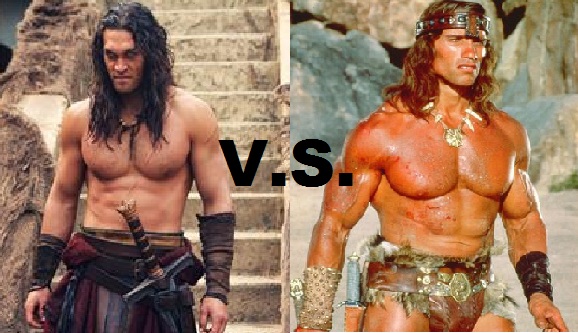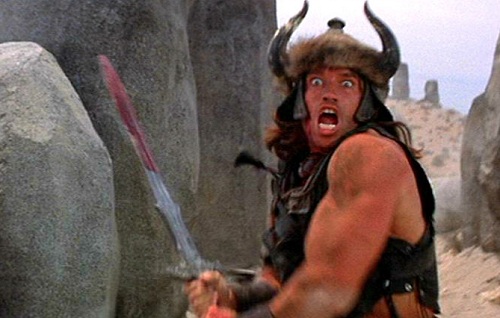Remakes are nothing new. From the silent era onward, filmmakers have returned again and again to the same stories, re-interpreting them and updating them either for the sake of modernization, to expose them to a broader audience or to just make more money. We modern film geeks tend to roll our eyes and groan cynically when a new remake comes down the pike, but the fact of the matter is that when done right there are few things as satisfying as a seeing a story we love get a good cinematic spit-shine. Remakes are a part of the grand tradition of storytelling and cinema history, and love them or hate them, they’re here to stay.
But in the last decade, the term “remake” has become something of a dirty word, and as a result Hollywood spin doctors and internet journalists have given us the new terms “reboot” and “re-imagining”. Do these terms actually have meaning, or are they just empty buzzwords? The mission statement of this ongoing column will be to answer that question by comparing an original film to a re-do and determining if the newer version fits one of the following definitions:
Remake: A straight re-telling of a story for the purpose of updating it for a contemporary audience, or making it accessible to a different culture or region.
Reboot: A course correction done with the purpose of restarting a franchise. A reset. Fealty to the original story or film is not a priority.
Re-Imagining: A re-telling of a story, but only in the broadest sense. Characters and some story elements may be retained, but mostly plot and story have been repurposed.
I also will make a judgment call on which version is superior. Some controversy may ensue.

CONAN THE BARBARIAN (1982) VS. CONAN THE BARBARIAN (2011)
The story: In an ancient age of swords and sorcery, a young boy witnesses the murder of his father and people at the hand of a despotic warlord. The boy grows up to be a skilled warrior and barbarian, and sets out on a quest to exact revenge against the warlord, who also happens to be a practitioner of evil magic and is intent on ruling the land with his dark power.
So what’s the deal?: When the 2011 version of Conan the Barbarian was released this summer, very few people referred to it as a remake. Of course very few people saw it to begin with and the film was one of the most high-profile flops of the year, but those who did see it seemed to allow it a wide berth from John Milius’s classic 1982 film of the same name. The consensus was that the new film was different enough to be taken on its own terms, and it reportedly drew its inspiration not from Milius’s film but from the original source material; meaning the pulp novels written by Robert E. Howard in the 1920’s. But is this really the case?
I would argue that Conan the Barbarian 2011 bears more than just a passing resemblance to the 1982 film, and in fact owes more to the Schwarzenegger star-making vehicle than it does to Howard’s work. Let’s look at the basic plot. As my story overview points out, the broad strokes are the same. As a boy, young Conan witnesses the death of his people and his father at the hands of a despotic madman, and grows up to seek revenge. “Well yeah,” you’re saying. “That’s the story of Conan.” Um, no it’s not. That’s the story of Milius’s Conan, not Robert E. Howard’s. On a fundamental story level, despite what it claims, the 2011 film is in fact a re-telling of Milius’s story.
But the devil’s in the details, right? Right. There are many details of the Marcus Nispel (a director known for his remakes of The Texas Chainsaw Massacre and Friday the 13th — itself a telling detail) film that echo Conan 1982. The most telling similarity is the sword made by Conan’s father. In both films it’s a distinctive broadsword with a cowskull on the hilt, and in both films it is acquired by the enemy and ultimately reclaimed by Conan, for whom it was originally intended. This is a story point created by Milius, not Conan’s creator. In Howard’s stories Conan’s father was a blacksmith, but that’s where the similarity ends. And no mention (to my knowledge; I haven’t read the completed works) is made of a sword that fits that description in the original novels. In the marketing for both films this sword is used in the exact same way in the Conan logo, inserted through the letters of his name. This is iconography that is specific to the Milius version. If the filmmakers and marketing department were intending to distance themselves from the original film, they did a really lousy job.
So in terms of basic story and iconography, Conan 2011 and Conan 1982 are the same movie. From here the dots get a little harder to connect, but there are distinct parallels. Take the characters for instance. Outside of Conan himself, none of the character names carry over from the original to the re-do. However, many of the character types are echoed. The antagonist of Milius’s film, Thulsa Doom, is a warlord/sorcerer/cult leader. The 2011 version splits this character into two, with Stephen Lang’s Khalar Zym being the warlord half and Rose McGowan’s Marique being the sorcerer half. In both films Conan’s love interest is a strong, capable woman, though Sandahl Bergman’s Valeria from the original is Conan’s equal where Rachel Nichol’s Tamara in the new film is not, and the characters do not really perform the same function in terms of story. So we’re definitely treading into “re-imagining” territory in terms of character. I did find it amusing however that in the 2011 film Conan briefly allies himself with a mustachioed thief, echoing Gerry Lopez’s sidekick character from the Milius’s film.
While the plot of the 2011 Conan doesn’t follow the 1982 plot beat for beat, there are again many similarities. In both films, Conan fights a giant creature in a pit. In both films, Conan is taught the “riddle of steel”. In both films, Conan is tasked with saving a female character who has fallen captive to the villain. It really does feel like the writers and producers of the new Conan sat down with the basic outline and character sheets from the 1982 film and scratched in a few name changes and detail adjustments when constructing the script. There’s also the similarity in regards to the casting of the leads. In 1982, Milius went with a then mostly unknown and untested quantity by casting body builder Arnold Schwarzenegger as his Conan. In 2011, Nispel pulled the same move by casting relative unknown and similarly physically intimidating Jason Mamoa as his Conan. One could argue that in both cases it was unlikely for either director to find a known actor capable of representing Conan’s physicality, but I don’t think that holds water. There are known actors working right now that could pull off Conan in terms of physicality; the Rock, Vin Diesel, etc. I think the people who made the new Conan film were very much looking to the Milius film in terms of how they modeled their production, and that went all the way down to casting the titular hero. Plus, it was probably cheaper.
Now there’s the part where we apply our terminology to determine 2011’s Conan the Barbarian as a remake, reboot or re-imagining. On one level, it is certainly a re-imagining. Details have been altered. But not enough. The basic story is the same. I would cite the 2004 Dawn of the Dead as a proper re-imagining; it presents a scenario you recognize from the original but nearly everything else, from character to story, is different. Conan 2011 would like you to think that it’s a reboot as it distinguishes itself from the “continuity” of the previous Conan films and was made for the (failed) purpose of re-starting a Conan franchise. But if the film exists solely as a reboot, why carry over any elements of Milius’s film, why not go straight to the Howard books for your story? Are there no other ways to tell the origin story of a barbarian? In my mind, the cleanest example of a reboot is Batman Begins; other than the basic conceit of the Batman character and origin, there are virtually no similarities to anything that was covered in a previous Batman film in terms of story. You definitely cannot call it a “remake”. The 2011 Conan film wants to have its cake and eat it too in that it wants to be a reboot but it falls back on the basic story of the original film. Thus, for all intents and purposes it is a remake.
Verdict: Remake.

Which is the superior version?: Though I found a few minor pleasures to be had in the remake (Mamoa’s performance, the opening act, some of the action and swordplay) it is the definition of mediocrity and cannot hold a candle to John Milius’s thematically rich and satisfying original film. Winner: Conan 1982 by a Hyborian mile.
Up next: Halloween (1978) vs. Halloween (2007)